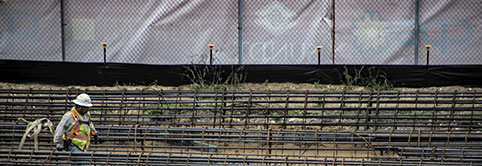Process Mapping
Introduction to Process Mapping
When utilizing Lean methodologies in design and construction, one of the main goals is to achieve standardization.
Standardization is the act of taking a process and making it “standard” across the board, ensuring that everyone understands and follows the process to increase consistency and reliability.
Standardization also provides a baseline that can then be improved upon. Without a standard process, it is impossible to implement improvements that can be made universally.
But in order to create a standard process, you must first understand what that process is. Process mapping is a great way to achieve this. As a visual medium, process maps can quickly communicate complex information to the entire team.
What is Process Mapping?
Process mapping is the act of taking a working process and visually mapping it out in clearly defined steps to increase internal understanding of the process and provide a standard that can be improved upon.
Types of Process Maps
Process maps come in many different shapes and sizes. Each one serves a slightly different purpose depending on the needs of the specific process you’re aiming to map out.
Basic Flowchart
Lists steps in sequential order. This flowchart may have one or two “decision” points that may send the worker back or forward a step in the process depending on pre-selected criteria, but is otherwise fairly uncomplicated.
Detailed Flowchart
Detailed flowcharts are the same as basic flowcharts, except that they are more detailed and thus may be more complex in nature. A detailed flowchart may have several decision points that may branch off into entirely new process flows or timelines, or may loop backwards or forwards several steps depending on pre-selected criteria.
Swimlane Diagram
A swimlane diagram is similar to a basic flowchart, except that it may include multiple parties in the process. For example, construction and design teams may be involved in the same working process, but the process may involve hand-offs from one team to another. This is easier to indicate when using a swimlane diagram.
Value Stream Map
Used throughout Lean processes, value stream maps are a type of process map used for value-providing processes to increase workflow efficiency by determining where value is being created in a process. Project teams may use value stream maps to identify waste in their working processes.
SIPOC
SIPOC stands for Supplies, Inputs, Processes, Outputs, and Customers. This high-level map is useful for visualizing the boundaries of scope and responsibility between different teams throughout a process, displaying how one step or component flows into another to create the complete timeline of events needed to reach an end result.
How to Process Map
1. Identify
To start, identify a process that needs to be standardized and mapped out. This can either be determined through a brainstorm where multiple processes are identified or through a discussion that reveals a crucial process lacks standardization across your project or company.
2. Define
Define the process to determine which type of flowchart will work best to map out the process.
3. List
Work with your team to list out all of the necessary steps for your process. Consider all variables and identify decision points. Determine whether you need to create any sub-processes within your process.
Getting input from many different perspectives reduces the chances that you will miss something when mapping out the process and also helps to increase understanding among the team.
One tip for this is to work backwards, starting from the end of the process. This will help you eliminate wasteful steps along the way.
4. Map
Once you’re confident in the process you and your team have put together, map it out visually. While mapping it out, you may realize variables or steps that you failed to consider when listing it out in the previous step.
5. Gather Feedback
Speak to those who will be implementing the process to ensure they understand what is being asked of them. Ask for their honest feedback so you can clear up confusion or implement improvements in real time.
6. Implement
Standardize and implement the process mapped out and educate your team on how to carry out the process properly.
7. Improve
Don’t allow your process to grow stale. Create a forum where team members can regularly share feedback and discuss how the process can be improved for the future.
Uses & Benefits of Process Mapping
1. Problem Solving
While not strictly a problem-solving tool, process mapping can help you uncover issues and misunderstandings that you didn’t know were present within a process.
Without consistent communication regarding how a process should be done, people will take things into their own hands by removing or adding their own steps, making assumptions, and creating “shortcuts”, all of which lead to diverging methods for completing a process. These problems are easily resolved through process mapping and standardization.
2. Continuous Improvement
Once you’ve created a standard for how a process should be done, it is quite easy to implement widespread improvement on that process. Prompt members to continuously seek ideas for improvement and discuss them with one another.
3. Streamlined Communication
Process maps can be easily displayed throughout the workplace, quickly communicating complex processes. This improved communication flow can break down silos and eliminate waste, allowing teams to focus more time on getting the work done.
4. Onboarding
As projects evolve, new people will join the fray. Getting people caught up to speed on the project and its processes can be a daunting endeavor. But with clearly laid-out process maps that define important pieces of the project, new team members can better educate themselves on the processes and quickly jump into the project to deliver value.
5. Documentation
Proper documentation of processes is beneficial for a number of reasons. For starters, you may need to refer back to a process later in the project and can quickly remind yourself how to accomplish the task with a process map.
Secondly, documentation will allow you to refer back to how the process was completed if you need to use it in other projects in the future – considering we often run into the same problems throughout our career.
Thirdly, documentation is the best way to ensure we continue to learn things. You never know when you or someone else you are working with will need to refer to what worked for you before.
Lean Assessments
How strong is your Lean knowledge? Take a Lean assessment to determine your current state so you have a baseline for improvement. Lean assessments are available for individuals, teams, and organizations alike. Whether you’re new to Lean or are an experienced Lean practitioner, Lean assessments are a great way to get started at LCI!
TAKE ASSESSMENTMore Lean Topics
From 5s to IPD, explore popular Lean design and construction topics below.




